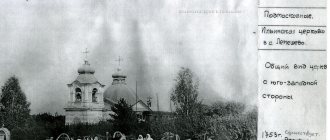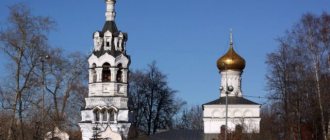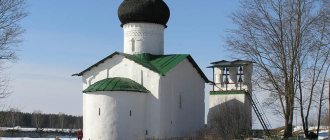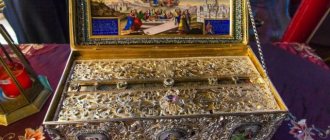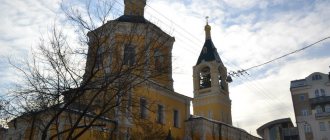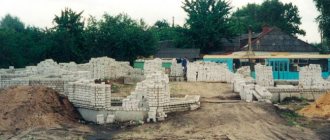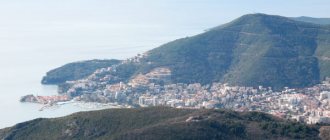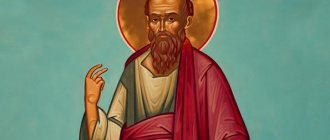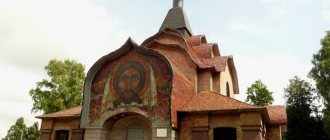Post-revolutionary time and recovery period
After the revolution, for several years until 1930, divine services were still held in the St. Nicholas Cathedral in Kislovodsk, after which it was closed, and in 1936 it was simply wiped off the face of the earth by a powerful explosion.
On the site of the cathedral, a park named after the leader of the revolution Lenin appeared, Cathedral Square in front of the once magnificent temple, and now the wasteland was renamed Red.
With the collapse of the Soviet Union, when the wind of change also affected attitudes towards churches and cathedrals, it was decided to restore the Kislovodsk shrine, using photographs from the 19th century as a basis.
St. Nicholas parish was revived in 1991, from mid-August of the same year, services became regular, Sunday school classes began, and in 1992, seminarians of the Orthodox St. Nicholas Classical Gymnasium began classes.
In 1993, on September 12, the first stone of the revival of St. Nicholas Cathedral in Kislovodsk was solemnly laid, but construction lasted for as long as 15 years.
On the day of honoring St. Nicholas the Wonderworker on May 22, 1997, thousands of people came to the first Divine Liturgy, after which a religious procession took place. In December of the same year, the belfry was replenished with three bells, and the first dome was installed. In 1999, the main dome was restored; in 2000, on the Bright Feast of the Resurrection of the Lord, regular services began in the St. Nicholas chapel.
Divine service in St. Nicholas Cathedral in Kislovodsk
Since the end of the last century, the restoration of the St. Nicholas Orthodox Cathedral has been going on for several years, which now looks majestic and solemn, being the cathedral church of Kislovodsk.
At the beginning of the first decade of the 21st century, the main church of Kislovodsk became truly popular, because it carries out a lot of social work with all segments of the population.
On May 22, 2008, on the feast of honoring St. Nicholas the Wonderworker and All Saints, His Eminence Clement, Metropolitan of Kaluga and Borovsk, as well as the ruling Bishop, Archbishop of Stavropol and Vladikavkaz Theophan, completely consecrated the new cathedral, which had risen from the ashes in all its beauty.
The appearance of the first branch of the women's rehabilitation center in 2009 gave hope to many women with addictions for a normal life, free from drugs and alcohol.
The newly erected temple buildings have four chapels:
- the main altar was consecrated in honor of the patron saint of the temple, St. Nicholas;
- on the south side a chapel of St. Alexy, Metropolitan of Moscow was built;
- on the north side you can pray in the chapel of Alexander Nevsky, the Russian Warrior;
- the lower (baptismal) altar is dedicated to the New Martyrs and Confessors of Russia.
The newly built Kislovodsk Cathedral of St. Nicholas the Wonderworker has become a worthy monument to the former shrine.
Temple of the Holy Prophet Elijah the Tezbite. Caucasian
“In 1794, during the settlement of the Kuban lands by Catherine II, there were settlers from the Don region from the villages of Verkhne and Nizhne-Chirskaya Pyatiizbyanskaya Cossacks-Old Believers, as well as Orthodox Christians. The number of Old Believer families is about half of the villagers. With the onset of spring 1795, work began to boil: axes clattered, saws squealed. The houses began to rise one after another. In the same year, a wooden chapel was built and consecrated in the name of St. Nicholas the Wonderworker. In the eastern part of the village, in a bend of the Kuban River, a monastery in the name of St. Nicholas is founded.
In 1820, another Old Believer chapel in the name of the Intercession of the Blessed Virgin Mary was founded in the center of the village. So, since then, Christian Cossack believers have sent their prayers to God in these two wooden chapels. During the granting of freedom to the believing Old Believers in 1905, the foundation was laid in the eastern part of the village of a new brick five-domed church in the name of the Ascension of the Lord. Funds for the construction of the temple were allocated by two Old Believers brothers, merchants Krasnov. The temple was erected in 1913. From this year the divine service was celebrated until 1933. During the repressions in 1933, the temple was closed and looted. And in 1940, the temple was completely destroyed and dismantled into collective farm barns. But the Cossacks-Old Believers did not lose heart and did not lose heart. Since 1933, after the closure of the Ascension Church, believers have sent prayers to God in a private house, right here in the village. It was provided by the Cossack Old Believer Gurov Taras Evlantievich. So, during the years of repression and during the war years, until 1949, the Old Believers prayed in this clay house. In 1949, due to the cramped space, Cossacks-Old Believers donated funds to purchase a larger room. In 1949, a large house was purchased on Dzerzhinsky Street. The temple was consecrated in the name of the Holy Prophet Elijah. They performed services to God until 1961. During Khrushchev's repressions and pressure on believers, the temple was forcibly taken away and closed. But the Old Believers did not lose heart. For six and a half years they worked through the Village Council, the region, Krasnodar, and Moscow to open a house of worship. So, after many years of trouble, the Kuban Cossacks-Old Believers in 1967 again obtained permission to worship. The tourist house of the Old Believers parishioner Ekaterina Nikolaevna Konovalova was rented for the temple, in which to this day believing Old Believers Christians send prayers to God for all believers and those in power.
In 1969, the house of worship was given a complete overhaul. The ceiling of the temple was raised and made into a dome. There is a chandelier hanging inside the temple. The temple is lined with bricks and the foundations are reinforced. It should be noted that every parishioner provided all possible assistance in the repairs.
This temple still exists today. And so we see that from the time the village was founded and settled by Cossacks-Old Believers, the church was immediately built. To this day, Christians pray in their church, subordinate directly to the Metropolitan of Moscow and All Rus' of the Belokrinitsky hierarchy Alimpiy.
And God grant that prayers be sent for peace on earth, happiness and prosperity, for the health of leaders in power, for the strengthening and power of our Motherland.”
Extract from the archive Art. Caucasian
***
On November 4, 1970, the Executive Committee of the Caucasian Regional Council of Deputies, Workers of the Krasnodar Territory, rented premises, previously owned by E.N. Konovalova, transferred free of charge to the executive committee of the Caucasian Village Council and was allowed to rent to the Old Believer Religious Society. On March 18, 1992, by Resolution No. 105 of March 18, 1992, the Head of the Administration of the Caucasian Village Council of the Caucasian District transferred the rented premises of the church to the Old Believer community free of charge.
Shrines and patronal feast days of the Kislovodsk Cathedral
The main shrine, to which the flow of parishioners and pilgrims does not stop, is the miraculous icon with particles of the relics of Nicholas of Myra.
Inside the Cathedral of St. Nicholas in Kislovodsk
In the spring on May 22 and in the winter on December 19, thousands of people come from afar for patronal feasts in honor of the patron saint of St. Nicholas Cathedral in Kislovodsk.
At the origins of faith in Kuban
There are not many churches with a two-hundred-year history in the Krasnodar region. The majestic church buildings that survived in the villages and cities during the anti-religious storm of Soviet times, now pleasing to the eye and delighting the soul, are “remakes” of the early 20th century. They were built either instead of dilapidated wooden churches erected by the founders of the villages, or stone ones, but dismantled due to their small capacity. The increasing population of villages and cities required spacious buildings. The St. Michael the Archangel Church in the village of Temizhbek, Caucasus region, will turn 206 years old this year. It became one of the shrines visited by pilgrims of the Vyselkovsky district. The trip to the Caucasian deanery of the Tikhoretsk diocese was organized by the parish of St. Nicholas Church of St. Vyselki together with the youth affairs department of the municipal administration and the Vyselkovsky district Cossack society.
REFERENCE
The Caucasian deanery of the Tikhoretsk diocese unites all municipal districts of the Caucasian region with the exception of the city of Kropotkin. In the east, the deanery borders on the Stavropol Metropolis, in the south – on the Armavir Diocese of the Kuban Metropolis. There are five churches in the deanery. The church in the village of Temizhbekskaya is one of the oldest in Kuban.
Icon from Athos
By the will of fate, the Vyselkovskoe and Caucasian deaneries turned out to be connected by a common history.
At the beginning of the 20th century, the temple in honor of the Archangel Michael, which was located in the center of the Kazan village, could no longer accommodate all the parishioners. At the village meeting, the Cossacks decided to build two more churches. The order for the construction of churches in the western and eastern parts of the village in 1912 was received by the architect Alexander Petrovich Kosyakin. It is believed that he, along with other churches in the Kuban, designed the Holy Trinity Church in the village of Novodonetsk.
Two years later, churches in Kazan were built and soon consecrated: one in honor of the Holy Trinity, the other in honor of the Great Martyr and Victorious George. They were identical in architectural design. The surviving photograph allows us to draw the same conclusion regarding the interior decoration - fragments of the iconostasis from the St. George Church, destroyed in the 70s of the 20th century, approached the iconostasis of its brother like family. The rector of the Holy Trinity Church, Archpriest Kassian Kravtsov, told the pilgrims about this.
Members of the Vyselkovo group venerate the icons of the Holy Trinity Church in the village of Kazanskaya, Caucasus region.
The temple has unique shrines. For example, the Tikhvin Icon of the Mother of God, the miracles of which were witnessed by parishioners of the temple. Or the icon of the Quick Hearer from Athos. As the inscription on the reverse side of the image says, “this holy icon was painted and consecrated on the Holy Mount Athos in the cell of the holy Apostle John the Theologian by Hieromonk Seraphim Titov on April 10, 1879.”
“And literally three months ago, particles of the relics of 16 saints of God were transferred to us from France for permanent storage,” Father Cassian told the Vyselkov delegation.
On the site of the destroyed St. George's Church, a chapel was built in honor of the holy great martyr. There is also a cross installed at the burial site of the soldiers of the Grechishkin hundred - the Cossacks of Andrei Grechishkin’s detachment, who prevented, at the cost of death, the invasion of 2 thousand Circassians into the territory of the Kuban in the area of the Zelenchuk River. In former times, outstanding people who were distinguished by their special love for the Fatherland and the Orthodox faith were buried on the territory of the churches. Cossacks and youth paid tribute to the memory of the legendary heroes.
The trip participants paid tribute to the memory of the Cossacks of the legendary Grechishkin hundred, who prevented the Circassian invasion of the Kuban territory at the cost of death.
Missionary heritage
The St. Nicholas Church of the Caucasian village was built in the Old Russian style: with very narrow windows and a high vault. This architectural solution creates special acoustics in the building. The pilgrims were convinced of this by performing a troparion to the patron of the temple - St. Nicholas the Wonderworker. St. Nicholas Church of the Caucasus is very musical. Church hymns on especially solemn holidays can be performed jointly by three members of the parish choir. There are just as many believers in the parish. Residents of the village value and respect the rector, Archpriest Georgy Maksimov, for his pastoral works.
In honor of the Archbishop of Myra, the main, upper limit of the temple was consecrated, the lower one is dedicated to the Iveron Icon of the Mother of God - the patroness of the North Caucasus. In the lower church there are the shrines of the temple: an icon of the righteous Theodosius of the Caucasus with a particle of relics, an icon with a particle of the relics of the holy great martyr Demetrius of Thessaloniki, a stone from the source of the holy martyr Basilisk of Koman (Abkhazia) and others.
In the lower limit of the St. Nicholas Church of the village of Kavkazskaya, Caucasus region, consecrated in honor of the Iveron Icon of the Mother of God.
The source of the Kazan Icon of the Mother of God, which is located not far from the village, is assigned to the temple. Initially, at the site where it came to the surface, the Nikolaev Orthodox missionary monastery was located. The source was famous throughout the entire region; from all the villages, seriously ill people were brought to it, not only from Kuban, but also from Stavropol, who, having plunged into the font, received consolation and healing. Often the image of the Most Holy Theotokos was seen in the water. In 1931 the monastery was closed, some of the brethren suffered martyrdom. The territory of the monastery is overgrown with forest. In 2008, through the efforts of the parishioners of St. Nicholas Church, the holy spring was rediscovered.
Vyselkovsky pilgrims plunged into the font and took in holy water. For some of them, immersion in holy waters was the first time in their lives.
Prayer service at the Cross installed near the source of the Kazan Icon of the Mother of God.
Cossack temple
The Church of the Archangel Michael in the village of Temizhbekskaya was built with money collected by the Cossacks - 15 thousand in silver - in 1811. It performed a double function: here the residents found consolation and prayed to God, and it was also a fortress that protected the villagers from the attacks of mountain peoples. In addition to the church, part of the stone railing with loopholes is original 19th-century masonry.
There are ancient icons on the walls. “The icon [of the Holy Blessed Prince Alexander Nevsky] was built by the society of the village of Temizhbek in memory of the martyrdom of Emperor Alexander Nikolaevich on March 1, 1881,” the inscription at the bottom of the canvas tells descendants. “The image [of St. Ephraim the Syrian] was built by Colonel Lev Yakovlevich Verbitsky in memory of his brother Ephraim Yakovlevich Verbitsky, major general of the Kuban Cossack army of 1820 - 1891,” informs the plaque on another icon.
Modern Cossacks also do not forget their roots. There are boards in the temple listing the names and surnames of the Cossack generals of the village, atamans, Cossacks who defended the village from Circassian raids, Knights of St. George and other heroic fellow countrymen. And in front of the temple, at the expense of the residents of the village, the “Arkhangelsk Glory” park was laid out and a memorial to the Cossack heroes of the First World War was built.
Photo against the backdrop of the Church of the Archangel Michael in the village of Temizhbek, Caucasus region.
It seems that there is no better place for a visual study of the Cossack history of Kuban.
The participants of the pilgrimage trip thank the dean of the Caucasian church district, Archpriest Kassian Kravtsov, and the Holy Trinity parish for the warm welcome.
| OPINION Chief of Staff of the Vyselkovsky Village Cossack Society Sergei Tishchenko : – I liked the trip. Getting to know the temples was very interesting. It’s good that we visited the burial places of the Cossacks of the centurion Grechishkin and paid tribute to them. Conversations by the staff priest of St. Nicholas Church St. The settlements of Father Anthony Ushakov were spiritually useful and instructive. Thanks to such trips, you discover new shrines and beauties of your native land. |
The material was published as part of the implementation of the winning project “Native Side” of the international grant competition “Orthodox Initiative 2016-2017”. |
